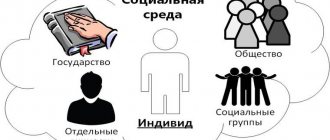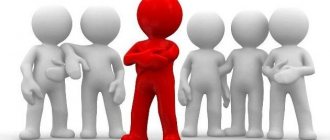The explanation of how an individual differs from a person lies in the duality of human nature. A person is born with a set of unique characteristics and properties. One can speak of a baby only as an individual, a representative of the species Homo sapiens. Life in society gives each individual the opportunity to socialize, develop their natural inclinations and form personal qualities. We can talk about such characteristics of a person as personality and individuality only when he is a full member of society.
Numerous examples from life, when, for various reasons, small children find themselves in the company of animals, confirm that the development of man as an individual continues according to general laws. The child grows, but does not acquire personal qualities, as he is deprived of human communication. This confirms the significant role of socialization in the formation of personality.
Let's give a terminological definition with brief characteristics
I will list the most popular words that are often confused by ordinary people. Let's take a wide range of explanations - from everyday and colloquial to scientific.
Human
First of all, this name is used in biology, history, and archeology to distinguish a biological species that has certain structural features of the body and brain. It is an upright creature endowed with cognitive abilities. The word is appropriate to use both in combination with the more social “humanity” and when contrasted with the animal world. This can be called absolutely every one of our “relatives” - from children to adults.
Characteristic features that distinguish a person from a personality:
- The result of the evolutionary process.
- The presence of consciousness and self-awareness.
- The need to be in society, the need to communicate with others like oneself.
- A single way of communication through language, that is, the work of speech recognition and speech reproduction, with the exception of those who have lost the opportunity or have not had it since birth due to their anatomical structure.
- Features of anatomy - upright posture, the presence of fingers and toes.
- The ability to use devices to achieve a goal - any objects used for their intended purpose.
Subjective meaning (that is, a person as a subject of relationships, historical process and cultural) turns a biological species into a social being.
Individual
From Latin the word individuum is translated as “indivisible.” We actually completely copied it (but the meaning of “individual” is still different).
This concept can be called every person living in a group, society and possessing qualities that make him the same as his closest relatives. However, it is an independent unit with intrinsic value. This occurs due to the uniqueness of each individual organism on two levels - physiological and psychological. These are not qualities acquired over the years, but traits that are innate - narrow or wide-set eyes, the presence of a dimple on the chin, timbre of voice or ringing laughter.
Characteristics, what is the difference between an individual and personality:
- The object of the human population cannot be alone, it is inseparable from its own kind.
- Social activity - the presence of roles, statuses, for example, husband or wife, daughter, son, mother, father or neighbor, teacher, friend.
- The ability to adapt on a psycho-emotional level to those around you – the ability to find a compromise and adapt to the demands of society.
These are any qualities that are determined in comparison with other people, in contrast or in accordance.
How personality differs from individuality and individual, examples
The term comes from the word “Person”, and in English the tracing paper from Latin is established - persona.
The definition is inextricably linked with personal qualities, that is, it continues the concept of individuum, making it even more personalized. If earlier we talked about the individual characteristics that a person had innately, now it is more correct to talk about the acquired character, which is revealed in communication and relationships with other people. It is impossible to talk about personal traits without comparison or contrast with society.
Psychologist Daria Milai
Make an appointment
The term is used in many sciences and reflects individual characteristics. Let's go through scientific areas:
- Linguistics. “Language, speech and communicative personality.” Everything can be tied into a single knot; often these three persons develop synchronously. They are all in one person. The quality can be called acquired, because the child at birth does not have speech. The first concept reflects the depth of constructed thoughts, sentences, and the structure of texts. The second explains the degree of verbal expression skill. The third is the ability to engage in various verbal interactions.
- Philosophy. In this science, the most common interpretations of the term appeared; it became a stumbling block. For the first time, the concept of “face” began to reflect a person and his inner world. Over time, philosophical wrangling, experts came to a consensus that a person, unlike an individual, has three traits: free will, reason and feelings.
- Sociology. There are many ideas, but the fundamental one is how the society in which a person lives affects his personal qualities, abilities, and character traits. This once again emphasizes the social orientation of the term.
- Psychology. Perhaps the psychological approach is the most correct. It is at the level of consciousness and the unconscious that a set of developed habits, preferences, experience, knowledge, established opinions and stereotypes of thinking appears. All these features determine a person’s attitude to nature, culture, history, and other people.
Let's give an example. Having your own opinion about the political situation means having the traits of personal development. A young man, and especially a child, can only repeat what was said or heard on TV, but not generate his own assessment.
Personality and man, what is the difference, characteristic features:
- presence of temperament;
- pronounced character - people talk about his inclinations even in infancy;
- individual abilities - they need to be developed;
- all actions have motivation.
In general, we can say that personal qualities are cultivated in oneself and controlled, adjusted independently.
Face-to-face consultation
What are the features and advantages of face-to-face consultation?
Find out more
Skype consultation
What are the features and benefits of Skype consultations?
Find out more
Individuality
The last term that is often confused within the listed definitions. Usually it is understood as personal striking features. The word has its root in the same Latin individuum, that is, “indivisible.” The differences between an individual’s personality and individuality are that the latter distinctive features can be displayed not only in behavior and psychology, but also in purely external manifestations. An example is an individual, author’s, unique style of clothing.
If you feel ordinary, one in a million, and do not find any special characteristics in yourself, this may mean:
- either you have nothing to express;
- or you don't know how.
In my personal consultations, women open up and learn to better understand themselves.
Expression of individuality
The concepts of “personality and individuality” cannot be identified, since the first concept is a characteristic of the second. It is individuality that gives a person a set of unique properties and traits that distinguish him from the social mass.
Personality is an expression of an objective assessment of a person and his compliance with society, and individuality is self-esteem, a subjective perception of oneself from the point of view of acquired qualities.
A person can show his individuality in different areas of activity: in profession, in creativity, in communication. Individuality makes it possible to demonstrate versatile abilities while maintaining the integrity of the psyche.
A person’s individuality is in constant dynamics, manifesting itself in various unexpected situations and conditions. A person’s individual qualities find their vivid expression at critical moments, when it is necessary to quickly make a non-standard decision or take responsibility. At the same time, society’s assessment will not always be positive. The reaction from the outside is an additional stimulus for the development of the subject, determining its direction.
If there is a stop in development, then we can talk about degradation. Its causes can be internal motives, as well as the influence of external factors, when suppression or submission to someone else’s will occurs, excluding the choice of actions or deeds.
What characterizes a person as a person
Initially, the word was almost a dirty word. This term is derived from "Face", and this word, in turn, had a negative connotation in everyday life. It meant what we would now call a mask, a role played—deception. For a long time, the concept was not applied directly to people; about the part of the body that we now call so, they said “face”, “guise”.
From this we can deduce the following. Just as an actor puts on a mask during a performance, so an individual becomes a person only in the process of interaction with other people - a kind of role that the character has built for himself.
Properties
I will list those aspects of life that, one way or another, influenced the formation:
- hereditary predisposition;
- parental education (these two factors are easy to confuse; it is often said that the child’s character is similar to the mother’s, but basically this is the adoption of habits);
- people with whom there is frequent interaction - friends, relatives, classmates, employees.
Particular personality traits may be expressed at one moment and deliberately or unintentionally suppressed at another. This is a significant difference between a personality and an individual, because the latter has a constant set of traits that he is not able to correct at will and through willpower, for example, eye color.
Individual characteristics
Having enormous potential for self-development and development as an individual, every person, after birth, manifests himself in certain properties. This is called individual development.
In social science, the concept of “individual” is used to denote the specific characteristics of an individual person. Firstly, each subject has unique external characteristics, eye color and bodily constitution, that is, he acts as a single representative of the species homo sapiens. Secondly, psychological differences can be identified between individuals: emotionality, temperament, character. Thirdly, everyone has a set of specific abilities.
From the point of view of some experts, the fetus in the womb already develops a peripheral and central nervous system in the second month. At five months, the embryo acquires the ability to hear and distinguish sounds, and in the third trimester it can already experience emotions (get scared, react to affection, conversations). Scientists insist that it is in the last months of gestation that the child’s intellectual abilities and psycho-emotional background are formed.
Therefore, there is an opinion that the formation of an individual begins not after birth, but immediately at the birth of a new life. We can briefly highlight its characteristics:
- high level of social activity;
- environmental sustainability;
- psychophysical unity of the organism.
The concept of “individual” in psychology is distinguished from the term “individuality”. It means a set of properties and features that determine the uniqueness of the subject. It manifests itself not only in behavior, but also in the specifics of preferences and interests. Individuality is formed in the environment in which the subject grows and develops, his associations acquired at an early age, and the characteristics of his upbringing. Psychologists say that one is born as an individual, one becomes an individual, and individuality must be defended.
The result of the development of an individual is a personality that is considered as an exclusively social entity.
What is individual?
The main difference is the lack of specific, unique features. This is a person who belongs to the crowd, has similar characteristics, conforms to basic stereotypes and is susceptible to public opinion.
Such a person has not grown personally. At the everyday level, we can cite the following traits of an individual who never became a person:
- inability to make decisions;
- lack of responsibility for events;
- low social adaptability;
- following the opinion of the majority;
- lack of point of view;
- the ability to manipulate the person in question.
Correlation of the concepts “individual”, “individuality”, “personality”
Man is noticeably different from all living beings. Personality, individual, individuality - these concepts can divide people into several categories, which makes them more complex in relation to other representatives of the animal world.
Any creature that belongs to the human race can be called by one term - an individual. But not every creature can be called a person. As mentioned earlier, to become a person, you must be highly developed. Also lead an active and successful life in society. That is, the concepts of “individual” and “personality” are not related. They are in a sense opposite. The same can be said about the relationship between the terms “individual” and “individuality”. The last concept characterizes personality. Individuality is an indicator of a person’s highly developed state.
The relationship between the concepts “individual”, “individuality”, “personality” should be considered as a kind of human evolution. At birth, he is in the first stage of development. Over time, he gains new properties that are mixed with his genetic information. It becomes unique, that is, it acquires individuality. Later he develops psychologically, becomes conscious, active, responsible, capable of successful interaction with the social environment. He can already be called a personality.
Thus, people can be divided into two broad categories. A non-developing person who uses only the basic properties given by nature, an uneducated person who does not play a special role in society, belongs to the first group. This is an individual. Individuality, personality - in psychology, these concepts characterize socially active people and form the second category.
What is an archetype in psychology and familiarity with Jung's prototypes?
What is individuality?
All manifestations can be divided into three large groups. These are the features:
- External. These include the uniqueness of the anatomical structure, the chosen style, and the way of dressing. Having an individual style means having a subtle feel for the combinations of clothes, shoes, and jewelry. Make sure that the image corresponds to the internal content and reflects it.
- Behavioral. These include: habits, habits (including negative ones), gait, non-verbal verbal methods of communication. These are any actions that are expressed through behavior. They are completely controlled by the individual. Although sometimes subconsciously.
- Mental. These include the expression of emotions, as well as resentment, anger, and envy. Their positive individual traits are humor, resourcefulness, perseverance, and good memory.
Talent needs to be highlighted separately. This is what distinguishes us greatly and qualitatively from the majority. While many people have creative abilities, often acquired over several years, there are very few truly talented performers, actors, and artists. They can definitely call themselves an individual.
Ask a question
Why a person is an individual: description
Every person is an individual. After all, we were all born on Earth and are representatives of the human race. In most modern theories, what distinguishes humans from animals is culture, which plays a decisive role in determining human behavior and actions. After all, human nature is recognized as binary, that is, man is a biosocial being.
A table proving that a person is an individual.
| Animal | Human |
| Life is accompanied by instincts. | Along with instincts, a person has thinking and articulate speech. This directs human activity. |
| All actions are initially programmed; the activities of animals are unconscious. | Carries out conscious, purposeful creative activity. A person is able to keep his instincts under control. |
| Reproduces only its biological essence. The tools of their labor are primitive objects of the environment. | Reproduces its not only biological, but also social essence; makes tools; creates material and spiritual values. |
“Individual” and “individual” - what is the peculiarity
The difference is made not depending on the properties of a person, but in connection with the situation. So let's imagine 2 circumstances. In the first, citizen A, like one of the previous 100, comes to a credit institution, provides a package of documents, and concludes a deal. It is difficult to assess his individual qualities here, because they actually could not manifest themselves in the most formalized setting. If you look at him as one out of 100, then he is an individual.
Second example. Citizen B is communicating with two people. She differs from them in gender, age, character, social status (wife, mother, sister) - and these differences in this particular case, in this society, are significant. This is where the individual comes into play.
Individual behavior
Behavior is a special form of activity of the human body, which masters the environment. In this aspect, behavior was considered by I. Pavlov. It was he who introduced this term. With the help of this term, it has become possible to display the sphere of relationships between an individual interacting individual and the environment in which he exists and interacts.
Individual behavior is the individual’s reaction to any changes in external or internal conditions. It can be conscious or unconscious. Human behavior develops and is realized in society. It is associated with goal setting and speech regulation. The behavior of an individual always reflects the process of his integration into society (socialization).
Any behavior has its reasons. It is determined by the events that precede it and cause a certain form of manifestation. Behavior is always purposeful.
An individual's goals are based on his unmet needs. Those. any behavior is characterized by the goal that it seeks to achieve. Goals perform motivating, controlling and organizational functions and are the most important management mechanism. To achieve them, a number of specific actions are performed. Behavior is also always motivated. Whatever the behavior, challenging or detached, it necessarily contains a motive that determines the immediate form of its manifestation.
In the process of technological progress in modern science, another term has appeared - virtual behavior. This type of behavior combines theatricality and naturalness. Theatricality is due to the illusion of natural behavior.
The behavior of an individual has the following characteristics:
- level of activity (initiative and energy);
- emotional expressiveness (the nature and intensity of manifested affects);
- pace or dynamism;
- stability, which consists in the constancy of manifestations in different situations and at different times;
- awareness based on understanding one’s behavior;
- arbitrariness (self-control);
- flexibility, i.e. changes in behavioral reactions in response to environmental transformations.
How does personality differ from individuality or individual?
The main difference is maximum self-awareness and the ability to control one’s own actions, take responsibility for them, and make decisions. The peculiarity is in willpower, which is expressed not in the desire to be different from others, but in the desire to become better than oneself. Usually, personal qualities, although they are manifested in comparison with others, are assessed by the person himself in relation to himself. That is, for example, the abstract “I” stole and has pangs of conscience not because a neighbor/friend or a policeman said that this should not be done. The reason is the awareness of values and their violation. The individual will be ashamed first of all of himself.
Concept of biological being
The term “human” is used in society as a general concept that characterizes a biological being. This is the highest stage of evolutionary development, which is the result of socio-historical processes, activity and communication. The definition is used to display and characterize the universal qualities and characteristics inherent in all people without exception.
The concept of “human being” used in psychology combines the characteristics of both a biological and a social being that is capable of influencing the environment in the course of its life activities. Belonging to the class of mammals and the species Homo sapiens determines the presence of certain characteristics:
- special physiological structure;
- ability to engage in various activities;
- the presence of consciousness and understanding of ongoing processes in the surrounding world;
- the ability to create the fruits of one’s own labor or the tools to obtain them.
Proponents of philosophy call a person a single organism, an integral system, the main elements of which are the physical and mental principles, the genetically inherent and subsequently formed unity of natural, spiritual, and social qualities.
It is common for a person to be aware of the structure of his own activities. This is called the goals and motives of work. Each subject in society has his own personal motives, reasons and intentions. Any human activity is assessed by the degree of motivation and specific focus. In addition, a creature representing the highest stage of evolution is characterized by all muscular movements and conscious use of the speech apparatus.
Unlike other representatives of the class of mammals, humans tend to acquire the ability to perform certain movements, and not use only innate ones. In addition, human movements and actions are performed using means of communication: facial expressions, gestures, speech.
Due to the development of abilities different from those given at birth, a person becomes an individual and a personality, and therefore ceases to be a primitive creature identified with primates. At the same time, one should distinguish the concept of “individual”, which characterizes outstanding people who demonstrate a high degree of socialization (the desire to stand out and be out of the crowd).
What is the difference between an individual and an individual?
Although these two words have the same root, they have completely different meanings. The first term can be applied to virtually any person who lives among people, has adapted to society and is not only a biological species, but also a representative of society. But the second definition involves the development of the individual. You can develop natural, innate properties (never cut your hair, they will grow to incredible sizes), or you can get acquired ones.
Often people consider themselves individuals only because they try to go against the general opinion. Such informals really differ from the crowd, but the problem is that there are a lot of them, they are already creating their own informal mass. Among her, tattoos, ripped jeans, green hair and ear tunnels become commonplace. Thus, only one that is invented independently and not copied from another can be considered an individual solution.
conclusions
Having answered the question of how a personality differs from an individual and individuality, we can conclude that these definitions, or rather characteristics, are closely intertwined with each other. A person receives individual properties and qualities at birth, but an understanding of all the features of life in society comes to him in the process of growing up, not only physically, but also psychologically. Social institutions contribute to the comprehensive development of the subject, and throughout his life he faces an important task - to preserve his individuality and remain an individual.
What does “outstanding personality” mean in social studies?
We come across all the terminology listed above at school. But the basis for everything is human predispositions. The structure of human development can be presented sequentially as follows:
- Congenital prerequisites - physical and genetic characteristics.
- Upbringing, communication, political situation, cultural influence or lack thereof.
- Perception of social taboos, prohibitions, requirements, norms, traditions, rituals.
- Self-adjustment of behavior.
- Active exploration of the world through books, textbooks, films and communication with people.
- Forming your own opinions, beliefs, postulates.
Points 5 and 6 can alternate endlessly. This is a normal tendency for a mature personality. With the progress of knowledge, changes occur. If they have not been there for 30-40 years or more, we can talk about orthodoxy and rigidity of thinking.
An “outstanding personality,” according to a social studies textbook, has the following qualities:
- strength of will;
- determination;
- extraordinary abilities, including mental and physical.
Social individual
Unlike young animals, the individual is practically devoid of innate adaptive instincts. Therefore, for survival and further development, he needs communication with his own kind. After all, only in society will a child be able to realize his innate potential and become an individual. Regardless of what society an individual is born into, he will not be able to do without the care and teaching of adults. For full development, a child needs a long time so that he can absorb all the elements and details that he will need in independent life as an adult member of society. Therefore, from the very first days of life, a child needs to be able to communicate with adults.
The individual and society are inseparable. Without society, an individual will never become an individual; without individuals, society simply will not exist. In the initial period of life, interaction with society consists of primary facial reactions, body language, with the help of which the baby informs adults about his needs and shows his satisfaction or dissatisfaction. The responses of adult members of a social group also become clear to him from facial expressions, various gestures and intonations.
As the child grows up and learns to speak, the language of gestures and facial expressions gradually fades into the background, but never throughout the adult life of the individual it completely loses its significance, transforming into the most important tool of nonverbal communications, which expresses feelings sometimes no less, and sometimes and more than ordinary words. This is due to the fact that gestures, facial expressions and postures are less controlled by consciousness than speech, and therefore, in some cases, are even more informative, telling society what the individual wanted to hide.
So, we can confidently say that social qualities (for example, communication) should be formed only in the process of interaction with society in general and communication with other people in particular. Any communication, verbal or non-verbal, is a necessary component for a person to become socialized. The social qualities of an individual are his abilities for social activity and the process of socialization. The earlier the socialization process begins, the easier it will be.
There are various forms of learning through which an individual is socialized, but they should always be used in combination. One of the methods that adults consciously use to teach a child to socially correct and approved behavior is reinforcement learning. Consolidation is realized through the targeted use of the method of rewards and punishments in order to demonstrate to the child which of his behaviors will be desired and approved, and which will be disapproving. In this way, the child is taught to comply with the elementary requirements of hygiene, etiquette, etc. that apply in society.
Some elements of an individual’s everyday behavior can become quite a habit, which leads to the formation of strong associative connections – the so-called conditioned reflexes. One of the channels of socialization is the formation of conditioned reflexes. Such a reflex, for example, could be washing your hands before eating. The next method of socialization is observational learning.
An individual learns how to behave in society by observing the behavior of adults and trying to imitate them. Many children's games are based on imitating the behavior of adults. Role-based social interaction of individuals is also learning. An adherent of this concept, J. Mead, believes that mastering social norms and rules of behavior occurs through interactions with other people and through various games, especially role-playing games (for example, playing mother and daughter). Those. learning occurs through interaction. By participating in role-playing games, the child brings to life the results of his own observations and his initial experience of social interaction (visiting a doctor, etc.).
Socialization of an individual occurs through the influence of various agents of socialization. The most important and first such agent in the process of social formation of an individual is the family. After all, it is the first and closest “social environment” of the individual. The functions of the family regarding the child include caring for his health and protection. The family also satisfies all the basic needs of the individual. It is the family that initially introduces the individual to the rules of behavior in society and teaches communication with other people. In the family, he first becomes acquainted with gender role stereotypes and undergoes gender identification. It is the family that develops the primary values of the individual. However, at the same time, the family is the institution that can cause the greatest harm to the process of socialization of the individual. For example, the low social status of parents, their alcoholism, conflicts in the family, social alienation or single-parent families, various deviations in the behavior of adults - all this can lead to irreparable consequences and leave an indelible imprint on the child’s worldview, his character and social behavior.
School is the next agent of socialization after family. It is an emotionally neutral environment, which is fundamentally different from the family. At school, the child is treated as one of many and in accordance with his real characteristics. In schools, children learn practically what success and failure are. They learn to overcome difficulties or get used to giving in to them. It is the school that forms an individual’s self-esteem, which, most often, remains with him throughout his adult life.
Another important agent of socialization is the environment of peers. During adolescence, the influence of parents and teachers on children weakens, along with this, the influence of peers increases. All academic failures and lack of parental attention are compensated by the respect of peers. It is among his peers that the child learns to resolve conflict issues and communicate as equals. And in school and family, all communication is built on hierarchy. Relationships in a peer group allow an individual to better understand himself, his strengths and weaknesses.
The needs of the individual are also better understood through group interaction. The social environment of peers makes its own adjustments to the value ideas instilled in the family. Also, interaction with peers allows the child to identify with others and, at the same time, stand out among them.
Since groups of different affiliations interact in the social environment: family, school, peers, the individual faces some contradictions. For example, an individual’s family values mutual assistance, but at school the spirit of competition dominates. Therefore, an individual has to feel the influence of different people. He tries to fit into different surroundings. As an individual matures and develops intellectually, he learns to see such contradictions and analyze them. As a result, the child creates his own set of values. The formed values of an individual allow them to more accurately define their own personality, outline a life plan and become an proactive member of society. The process of forming such values can be a source of significant social change.
Also among the agents of socialization it is necessary to highlight the media. In the process of their development, the individual and society continuously interact, which determines the successful socialization of the individual.
Personal qualities
The definition of “personality” is understood as a specific subject who is distinguished by the ability of cognition, self-awareness, emotional experiences, as well as the ability to influence the world around him and build relationships with other individuals. Psychologists believe that this term refers to anyone who occupies a position in society and is capable of fulfilling a certain role.
Personality cannot be formed outside of society and without connection with it; its main characteristics are the following potentials:
- informative;
- creative;
- communicative;
- value;
- art.
The will of a responsible subject, the ability to control one’s life and build relationships are considered the basis for personal development. These are individuals who understand that natural inclinations cannot control the mind, and a person must consciously guide his own behavior.
For example, a three-year-old child cannot be considered a mature personality. He is not yet aware of why he acted this way and not otherwise, and what consequences his action may lead to. He acts based on his upbringing and habits that he developed in childhood.
It is difficult to call a person who does not have a stable, solid “I” a personality. Many people live in a pattern, mechanically reacting to what is happening in the world around them, and follow exclusively their instincts. If there are adequate habits and their reasonable external manifestations, a decent person appears in society, but without his own “I”.
The formation and definition of a person as an individual is a long process that is associated with:
- with the choice of social roles and functions performed;
- awareness and acceptance of rules and norms of behavior;
- the ability to build relationships and be part of society;
- choose your behavior model responsibly and independently.
It should be understood that in society those who are capable of being different from everyone else always attract attention. But psychologists focus on those features that make this happen. One can always be called a person who knows how to stand out, but not everyone who stands out has the right to be considered a person. Only worthy behavior is the main social characteristic of a subject. Outstanding people have always been distinguished by their determination and willpower, and they are usually perceived as role models.
Equality of biological and social
Currently, many psychological concepts are proposed, according to which the personality is not only a subject of a social system and not only a biological organism, it can be considered as a specific integrative formation that equally unites:
- biological characteristics of the individual (as a representative of the human species);
- social functions and roles of the individual (as a subject of social relations and activities) (see Fig. 1).
Memory theory
People have different impressions of the world around them. They leave traces, remain, are recorded, and if necessary and possible, these impressions are copied. These processes are called memory. S. Rubinstein said that without memory a person will become a moment of the future with a dead past. Without memory, the functioning of society and humans is impossible. Experts believe that the most developed part of psychology is memory, but further study of its patterns makes memory one of the key problems of science. Today there is no single and complete theory of memory.
1. Psychological theories of memory are represented by a number of different directions:
— Associative direction, the central concept of which is association. The essence of this principle is as follows: if certain spiritual forms appear in consciousness simultaneously or one after another, then associative connections are formed between them. Thus the representation of all the elements comes to mind when any element of this compound appears again;
- Gestaltism. The main concept of this direction is the concept of gestalt. This concept denotes an entire structure that cannot be reduced to the sum of its constituent parts. The basis for the formation of connections is the organization of material according to the principle of isomorphism - similarity in form and can only be realized as a result of the activity of the subject;
— Personal activity. This direction is gaining recognition and considers activity as a factor determining the formation of all its mental processes, including the memory process. The process of memorization, preservation and reproduction is determined by the significance of the material in the subject’s activity;
— Physiological theories of memory. They have a close connection with the teachings of I.P. Pavlova on the laws of higher nervous activity. This is the theory of “memory at the physiological level.” This physiological basis of memorization is a conditioned reflex as an act of forming a connection between new and already fixed content. The concept of reinforcement here becomes of great importance for understanding the causality of this act. Reinforcement is the achievement of an immediate goal by an individual’s actions;
— Physical theory of memory. The authors of this direction believe that any nerve impulse, passing through a certain group of neurons, leaves a physical trace, the materialization of which is expressed in electrical and mechanical changes in synapses;
— Biochemical theories of memory. At the present stage of studying the mechanisms of memory, there is an increasing convergence of the neurophysiological with the biochemical level, which is confirmed by the research conducted. As a result of the research, a hypothesis was put forward that the memorization process is two-stage in nature. In the first stage, short-term electrochemical reactions occur in the brain, which cause reversible physiological changes in cells. The first stage is based on the second stage, namely the actual biochemical reactions associated with the formation of new protein substances. According to supporters of this theory, these specific chemical changes are the basis of the mechanism for fixation, preservation and reproduction of trace processes [4].
Thus, we can say that various theories considered the development of memory from different points of view - from the point of view of associations, structuring of material during memorization, from the point of view of reinforcement, the formation of semantic connections.










